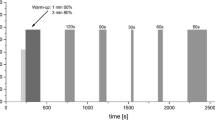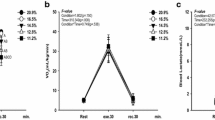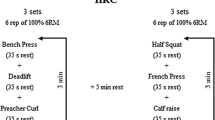Abstract
Purpose
The aim of this study was to assess the acute cardiorespiratory as well as muscle and cerebral tissue oxygenation responses to submaximal constant-load (CL) and high-intensity interval (HII) cycling exercise performed in normoxia and in hypoxia at similar intensity, reproducing whole-body endurance exercise training sessions as performed in sedentary and clinical populations.
Methods
Healthy subjects performed two CL (30 min, 75% of maximal heart rate, n = 12) and two HII (15 times 1-min high-intensity exercise—1-min passive recovery, n = 12) cycling exercise sessions in normoxia and in hypoxia [mean arterial oxygen saturation 76 ± 1% (clamped) during CL and 77 ± 5% (inspiratory oxygen fraction 0.135) during HII]. Cardiorespiratory and near-infrared spectroscopy parameters as well as the rate of perceived exertion were continuously recorded.
Results
Power output was 21 ± 11% and 15% (according to protocol design) lower in hypoxia compared to normoxia during CL and HII exercise sessions, respectively. Heart rate did not differ between normoxic and hypoxic exercise sessions, while minute ventilation was higher in hypoxia during HII exercise only (+ 13 ± 29%, p < 0.05). Quadriceps tissue saturation index did not differ significantly between normoxia and hypoxia (CL 60 ± 8% versus 59 ± 5%; HII 59 ± 10% versus 56 ± 9%; p > 0.05), while prefrontal cortex deoxygenation was significantly greater in hypoxia during both CL (66 ± 4% versus 56 ± 6%) and HII (58 ± 5% versus 55 ± 5%; p < 0.05) sessions. The rate of perceived exertion did not differ between normoxic and hypoxic CL (2.4 ± 1.7 versus 2.9 ± 1.8) and HII (6.9 ± 1.4 versus 7.5 ± 0.8) sessions (p > 0.05).
Conclusion
This study indicates that at identical heart rate, reducing arterial oxygen saturation near 75% does not accentuate muscle deoxygenation during both CL and HII exercise sessions compared to normoxia. Hence, within these conditions, larger muscle hypoxic stress should not be expected.








Similar content being viewed by others
Abbreviations
- ANOVA:
-
Analysis of variance
- CL:
-
Constant-load exercise
- FiO2 :
-
Inspiratory oxygen fraction
- HbO2 :
-
Oxygenated hemoglobin
- HbTot:
-
Total hemoglobin
- HHb:
-
Deoxygenated hemoglobin
- HII:
-
High-intensity interval exercise
- NIRS:
-
Near-infrared spectroscopy
- RPE:
-
Rate of perceived exertion
- SpO2 :
-
Arterial oxygen saturation
- TSI:
-
Tissue oxygenation index
References
ACSM (1998) American College of Sports Medicine Position Stand. The recommended quantity and quality of exercise for developing and maintaining cardiorespiratory and muscular fitness, and flexibility in healthy adults. Med Sci Sports Exerc 30:975–991
Al-Rawi P, Kirkpatrick P (2006) Tissue oxygen index: thresholds for cerebral ischemia using near-infrared spectroscopy. Stroke 37:2720–2725
Amann M, Romer LM, Subudhi AW, Pegelow DF, Dempsey JA (2007) Severity of arterial hypoxaemia affects the relative contributions of peripheral muscle fatigue to exercise performance in healthy humans. J Physiol 581:389–403
Ameln H, Gustafsson T, Sundberg CJ, Okamoto K, Jansson E, Poellinger L, Makino Y (2005) Physiological activation of hypoxia inducible factor-1 in human skeletal muscle. FASEB J 19:1009–1011
Billaut F, Buchheit M (2013) Repeated-sprint performance and vastus lateralis oxygenation: effect of limited O(2) availability. Scand J Med Sci Sports 23:e185–e193
Brocherie F, Millet GP, D’Hulst G, Van Thienen R, Deldicque L, Girard O (2018) Repeated maximal-intensity hypoxic exercise superimposed to hypoxic residence boosts skeletal muscle transcriptional responses in elite team-sport athletes. Acta Physiol (Oxf) (in press)
Chacaroun S, Borowik A, Morrison S, Baillieul S, Flore P, Doutreleau S, Verges S (2017) Physiological responses to two hypoxic conditioning strategies in healthy subjects. Front Physiol 7:675
DeLorey DS, Shaw CN, Shoemaker JK, Kowalchuk JM, Paterson DH (2004) The effect of hypoxia on pulmonary O2 uptake, leg blood flow and muscle deoxygenation during single-leg knee-extension exercise. Exp Physiol 89:293–302
Ferrari M, Mottola L, Quaresima V (2004) Principles, techniques, and limitations of near infrared spectroscopy. Can J Appl Physiol 29:463–487
Ferrari M, Muthalib M, Quaresima V (2011) The use of near-infrared spectroscopy in understanding skeletal muscle physiology: recent developments. Philos Trans Ser A Math Phys Eng Sci 369:4577–4590
Fluck M (2006) Functional, structural and molecular plasticity of mammalian skeletal muscle in response to exercise stimuli. J Exp Biol 209:2239–2248
Fulco CS, Rock PB, Cymerman A (1998) Maximal and submaximal exercise performance at altitude. Aviat Space Environ Med 69:793–801
Girard O, Malatesta D, Millet GP (2017) Walking in hypoxia: an efficient treatment to lessen mechanical constraints and improve health in obese individuals? Front Physiol 8:73
Gonzalez-Muniesa P, Lopez-Pascual A, de Andres J, Lasa A, Portillo MP, Aros F, Duran J, Egea CJ, Martinez JA (2015) Impact of intermittent hypoxia and exercise on blood pressure and metabolic features from obese subjects suffering sleep apnea-hypopnea syndrome. J Physiol Biochem 71:589–599
Gore CJ, Hahn AG, Aughey RJ, Martin DT, Ashenden MJ, Clark SA, Garnham AP, Roberts AD, Slater GJ, McKenna MJ (2001) Live high:train low increases muscle buffer capacity and submaximal cycling efficiency. Acta Physiol Scand 173:275–286
Hawley JA, Lundby C, Cotter JD, Burke LM (2018) Maximizing cellular adaptation to endurance exercise in skeletal muscle. Cell Metab 27:962–976
Hobbins L, Hunter S, Gaoua N, Girard O (2017) Normobaric hypoxic conditioning to maximize weight loss and ameliorate cardio-metabolic health in obese populations: a systematic review. Am J Physiol Regul Integr Comp Physiol 313:R251–R264
Hoppeler H, Klossner S, Vogt M (2008) Training in hypoxia and its effects on skeletal muscle tissue. Scand J Med Sci Sports 18(Suppl 1):38–49
Lundby C, Robach P (2016) Does ‘altitude training’ increase exercise performance in elite athletes? Exp Physiol 101:783–788
Lundby C, Steensberg A (2004) Interleukin-6 response to exercise during acute and chronic hypoxia. Eur J Appl Physiol 91:88–93
Macnutt MJ, De Souza MJ, Tomczak SE, Homer JL, Sheel AW (2012) Resting and exercise ventilatory chemosensitivity across the menstrual cycle. J Appl Physiol 112:737–747
Manukhina EB, Downey HF, Shi X, Mallet RT (2016) Intermittent hypoxia training protects cerebrovascular function in Alzheimer’s disease. Exp Biol Med (Maywood) 241:1351–1363
Masschelein E, Van Thienen R, D’Hulst G, Hespel P, Thomis M, Deldicque L (2014) Acute environmental hypoxia induces LC3 lipidation in a genotype-dependent manner. FASEB J 28:1022–1034
Mazzeo RS (2008) Physiological responses to exercise at altitude: an update. Sports Med 38:1–8
Millet GP, Roels B, Schmitt L, Woorons X, Richalet JP (2010) Combining hypoxic methods for peak performance. Sports Med 40:1–25
Millet GP, Debevec T, Brocherie F, Malatesta D, Girard O (2016) Therapeutic use of exercising in hypoxia: promises and limitations. Front Physiol 7:224
Mourot L (2018) Limitation of maximal heart rate in hypoxia: mechanisms and clinical importance. Front Physiol 9:972
Netzer NC, Chytra R, Kupper T (2008) Low intense physical exercise in normobaric hypoxia leads to more weight loss in obese people than low intense physical exercise in normobaric sham hypoxia. Sleep Breath 12:129–134
Ponsot E, Dufour SP, Zoll J, Doutrelau S, N’Guessan B, Geny B, Hoppeler H, Lampert E, Mettauer B, Ventura-Clapier R, Richard R (2006) Exercise training in normobaric hypoxia in endurance runners. II. Improvement of mitochondrial properties in skeletal muscle. J Appl Physiol 100:1249–1257
Pramsohler S, Burtscher M, Faulhaber M, Gatterer H, Rausch L, Eliasson A, Netzer NC (2017) Endurance training in normobaric hypoxia imposes less physical stress for geriatric rehabilitation. Front Physiol 8:514
Puthon L, Bouzat P, Robach P, Favre-Juvin A, Doutreleau S, Verges S (2017) Effect of ageing on hypoxic exercise cardiorespiratory, muscle and cerebral oxygenation responses in healthy humans. Exp Physiol 102:436–447
Richardson RS, Noyszewski EA, Kendrick KF, Leigh JS, Wagner PD (1995) Myoglobin O2 desaturation during exercise. Evidence of limited O2 transport. J Clin Investig 96:1916–1926
Roels B, Thomas C, Bentley DJ, Mercier J, Hayot M, Millet G (2007) Effects of intermittent hypoxic training on amino and fatty acid oxidative combustion in human permeabilized muscle fibers. J Appl Physiol 102:79–86
Rolfe P (2000) In vivo near-infrared spectroscopy. Annu Rev Biomed Eng 2:715–754
Schreuder TH, Nyakayiru J, Houben J, Thijssen DH, Hopman MT (2014) Impact of hypoxic versus normoxic training on physical fitness and vasculature in diabetes. High Alt Med Biol 15:349–355
Smith KJ, Billaut F (2010) Influence of cerebral and muscle oxygenation on repeated-sprint ability. Eur J Appl Physiol 109:989–999
Sorensen H, Rasmussen P, Siebenmann C, Zaar M, Hvidtfeldt M, Ogoh S, Sato K, Kohl-Bareis M, Secher NH, Lundby C (2015) Extra-cerebral oxygenation influence on near-infrared-spectroscopy-determined frontal lobe oxygenation in healthy volunteers: a comparison between INVOS-4100 and NIRO-200NX. Clin Physiol Funct Imaging 35:177–184
Subudhi AW, Dimmen AC, Roach RC (2007) Effects of acute hypoxia on cerebral and muscle oxygenation during incremental exercise. J Appl Physiol 103:177–183
Takano N (2000) Respiratory compensation point during incremental exercise as related to hypoxic ventilatory chemosensitivity and lactate increase in man. Jpn J Physiol 50:449–455
Toffoli S, Roegiers A, Feron O, Van Steenbrugge M, Ninane N, Raes M, Michiels C (2009) Intermittent hypoxia is an angiogenic inducer for endothelial cells: role of HIF-1. Angiogenesis 12:47–67
Van Beekvelt MC, Colier WN, Wevers RA, Van Engelen BG (2001) Performance of near-infrared spectroscopy in measuring local O(2) consumption and blood flow in skeletal muscle. J Appl Physiol 90:511–519
Vogt M, Hoppeler H (2010) Is hypoxia training good for muscles and exercise performance? Prog Cardiovasc Dis 52:525–533
Wehrlin JP, Hallen J (2006) Linear decrease in VO2max and performance with increasing altitude in endurance athletes. Eur J Appl Physiol 96:404–412
Wiesner S, Haufe S, Engeli S, Mutschler H, Haas U, Luft FC, Jordan J (2010) Influences of normobaric hypoxia training on physical fitness and metabolic risk markers in overweight to obese subjects. Obesity (Silver Spring, Md) 18:116–120
Willis SJ, Alvarez L, Millet GP, Borrani F (2017) Changes in muscle and cerebral deoxygenation and perfusion during repeated sprints in hypoxia to exhaustion. Front Physiol 8:846
Acknowledgements
We thank all the subjects for participating to this study, the “Fond de Dotation Agir pour les maladies chroniques” for financial support and the Lebanese University for their support with a PhD grant (CS).
Author information
Authors and Affiliations
Corresponding author
Ethics declarations
Conflict of interest
All authors declare to have no conflict of interest.
Additional information
Communicated by Jean-René Lacour.
Rights and permissions
About this article
Cite this article
Chacaroun, S., Vega-Escamilla y Gonzalez, I., Flore, P. et al. Physiological responses to hypoxic constant-load and high-intensity interval exercise sessions in healthy subjects. Eur J Appl Physiol 119, 123–134 (2019). https://doi.org/10.1007/s00421-018-4006-9
Received:
Accepted:
Published:
Issue Date:
DOI: https://doi.org/10.1007/s00421-018-4006-9




